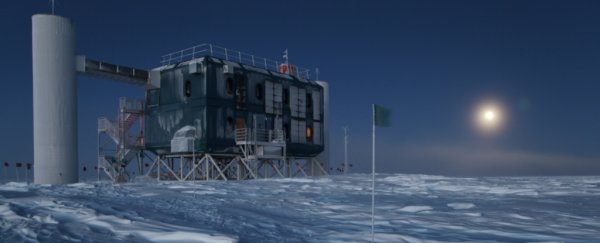Around the world, efforts are ramping up to try and uncover the mystery of fast radio bursts - extremely powerful, milliseconds-long radio bursts from somewhere out beyond the solar system.
We don't know what they are. We don't even know where most of them are coming from, since the majority of sources only emit a burst once and fall silent.
But the answer could lie with neutrinos - and that's where a telescope facility at the South Pole called IceCube comes into play.
We first learned of FRBs in 2007, when the first known and recorded burst was discovered in radio observation data from Australia's Parkes Observatory in 2001. The first live FRB was detected in 2015, again by the Parkes Observatory. Around two dozen FRB sources, both found in archived data and recorded live, have been detected.
"It's a new class of astronomical events. We know very little about FRBs in general," said physicist Justin Vandenbroucke of the University of Wisconsin, which operates IceCube.
IceCube is an optical telescope specifically designed to detect neutrinos, strange elementary particles that are almost massless, have a very small chance of interacting with regular matter, and travel almost at the speed of light.
They are possibly caused by highly energetic, violent events and objects such as black holes, gamma-ray bursts, galaxy clusters and active galaxies.
IceCube uses 5,160 optical modules to detect these tiny particles in the clear, dry, stable atmosphere of the South Pole, with an exceptionally wide field-of-view. When other radio telescopes detect an FRB, the IceCube team can cross-reference the radio data with their own data to check for elevated neutrino activity.
In fact, they have already done so for nearly 30 FRBs, including 17 from FRB 121102, which is an anomalous FRB source that has emitted multiple bursts.
The team found no unusual neutrino data, but that is not a null result. It helps narrow down what the FRBs are not.
"We've ruled out gamma-ray bursts and we've strongly constrained the possibility of black holes," Vandenbroucke said.
Radio telescopes are set to grow even more powerful over the next decade, with the Square Kilometre Array expected to become an FRB-hunting beast across the mid and low frequencies. Already the Australian Square Kilometre Array Pathfinder has detected three FRBs after it was only switched on in February of this year.
It's expected that FRBs will be detected with greater frequency, with some researchers hypothesising that they could be occurring across the universe as often as once a second.
"We can say that the amount of energy emitted by each burst as neutrinos is less than a certain amount, which can then be compared to predictions from individual theories," Vandenbroucke said.
"As the number of bursts is expected to grow dramatically in the next couple years, these constraints will become even stronger - or we will make a detection."
